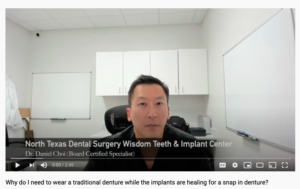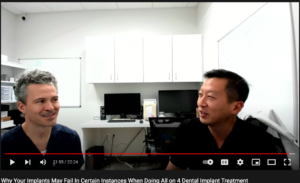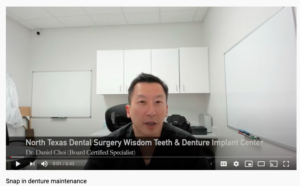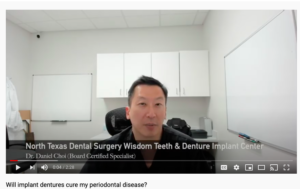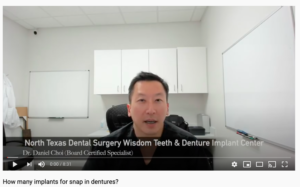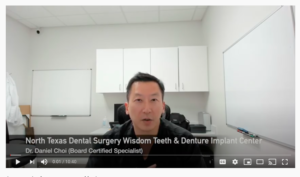Snap in Dentures
Before
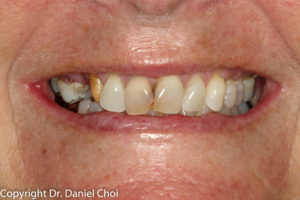
Before

After
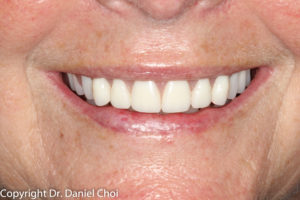
After
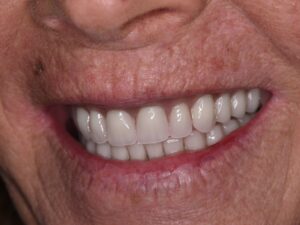
Snap-in Dentures | McKinney TX | Plano TX | Grapevine TX
Snap-in dentures are a great alternative to traditional dentures! It allows a person to be able to have a better functioning denture with the use of dental implants.
Dental implants are placed within your jaw and are the anchors upon which your dentist will place something called a locator abutment. The locator abutment serves as an attachment like a snap button that will attach to your denture.

In the image above, the dental implant is buried in your jaw bone. The locator abutment is the gold attachment that sits on top of the implant above your gums and snaps into the gray insert on the underside of the snap in denture.
Denture Problems
Why think about snap-in dentures? Traditional dentures are essentially large pieces of plastic that are shaped and colored to look like your natural teeth and gums. The denture is made to be customized for your mouth and needs to extend enough into the peaks and valleys of your mouth to create stability. All that plastic can literally be “a mouthful” and be very frustrating for patients.
Upper Dentures Problems
There are many problems with upper traditional dentures. An upper traditional denture has plastic that covers the roof of the mouth. As a result, this can cause problems such as:
-gagging: not everybody experiences it but if you’re a gagger, an upper denture will be very difficult to ever use due to how deep the plastic denture extends to the throat.
-poor fit and inability to eat food if the denture is improperly made.
-even if it initially fits properly, bone loss occurs over time leading to future improper fit and facial changes.
-loss of taste because of covering of the taste buds on your palate
-denture falling loose while speaking or eating.
Lower Denture Problems
Similar to an upper denture, a lower traditional denture has similar issues but more severe.
-gagging: gagging is not as severe with a lower denture, but severe gaggers still have problems with lower dentures
-poor fit: a poor fit is more severe with lower dentures because the retention and stability is even more dramatic.
-bone loss issues: bone loss affects the lower jaw as much as the upper jaw. However, bone loss in the lower jaw affects your lower denture stability and retention very severely.
-denture falling loose while speaking: more severe on the lower jaw than on the upper jaw. Patients are more dissatisfied with lower dentures because any time a patient speaks or eats with a lower denture, the denture destabilizes due to tongue movement.
I just had my first Post-Op after full upper and lower denture implants.
100% I made the right choice to go with Dr. Choi~”
What are the advantages of a snap-in vs a traditional denture?
When comparing a traditional denture to a snap-in overdenture, the biggest difference is stability and retention. Eating with a traditional denture is very difficult and can be frustrating. Wearing a traditional denture there is nothing holding it in place but suction and some denture adhesive. A snap-in overdenture has more stability and retention, therefore, making it more functional while eating and speaking.
Another difference between the two is the palate. A traditional denture has a full palate to it. It may feel very large in your mouth and can make you gag. Everyone has different gag reflexes, if you are more sensitive this may be an issue for you. Having the palate on your traditional denture also makes tasting food more difficult. When you eat, the roof of your mouth and tongue hold your taste buds. While wearing a traditional denture your tongue will be hitting plastic, not the roof of your mouth.
A snap-in overdenture does not have the palate. Because of this, it feels more similar to having your natural teeth. It isn’t as large and has more stability with less chance of popping out while talking or laughing.
Why is it important to choose the right specialist?
Snap in Denture Procedure
You have made the decision to get a snap in denture but, you’re wondering what are the steps? How long does it take? How much will it cost? We are here to answer all these questions for you!
Step 1: Consultation and 3D scan
At this consultation, your surgeon will need some diagnostic information to tell you whether you are a candidate for a snap on denture. What makes you a possible candidate or not depends on how much bone you have and your physical health. In a case where you don’t have enough bone, your surgeon will potentially be able to do bone grafting. Some surgeons will perform a 2D panoramic radiograph in your mouth. Select surgeons will have a much more diagnostic scanner in their office known as a 3D CBCT scanner. When doing your research for a surgeon, make sure you find a surgeon with a 3D CBCT scanner in their office. It provides more detail and allows a surgeon to better plan the procedure and have less unexpected scenarios. During this appointment, your doctor will take molds of your mouth, photographs, and plan your ideal smile by helping you pick the color and shape of your future teeth and gums. Finally, your surgeon will go over your medical health history to ensure you have a safe surgical procedure.
Step 2: Surgery
At this appointment, your surgeon will perform your surgery. Most patients will opt for sedation for their surgery. Click the following link to learn more about sedation. Some may already be missing their teeth, while others may still need to have their teeth extracted before placing the implants. Once the teeth are out, your jaw bone may need to be reduced and smoothed out to allow your future snap on denture to fit within your mouth. Once the bone is smoothed in a procedure called alveoplasty, your dental surgeon will place your dental implants. It is very important that your dental surgeon places your implants in the correct place and angulation to prevent any damage to vital structures such as nerves and arteries. Not only is proper placement important for avoiding vital structures, but is important for proper functioning of your snap in denture. If your implants are not placed in a parallel fashion, they could prevent your snap on denture from snapping on properly. After your implants are placed, your surgeon will place any additional bone if necessary and suture your gums shut. At the end of this appointment, you will be fitted with your temporary denture that you will wear for approximately 3-4 months while your implants heal. It is very important you be aware that it can be very frustrating wearing a denture while you heal. If you were wearing a denture before your dental implant procedure, then this 3-4 month period will be nothing new for you. However, if you’re used to having teeth and had them extracted during the procedure, wearing a denture for the first time will be an eye opening experience that can be very frustrating. Those denture problems we mentioned earlier in this article will be experienced during this healing period. Rest assured that these problems will not be experienced when you are in your final snap in denture.
Step 3: Follow up appointments
You will be going back to your dental surgeon for periodic follow-up appointments to ensure your mouth and dental implants are healing properly. During these appointments, any necessary adjustments to your temporary dentures can be addressed to ensure a more comfortable fit.
Step 4: Final snap in denture fitting
At the final series of appointments, your doctor will fit you for your final custom snap in denture. Your bone and gums will change significantly during the 3-4 month healing period, so it’s best to fit you for a new custom snap in denture.
Before
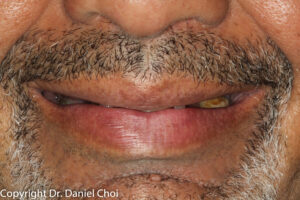
After
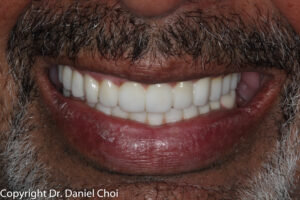
How much do snap-in dentures cost?
The big question is how much do snap-in dentures cost? The first question I typically ask is do you have dental insurance? Dental insurance may cover part of your surgical procedure, such as the extractions and/or implants. However, your insurance is typically capped out at a maximum amount such as $1000-$2000 per year so that amount would be applicable towards your total cost of the procedure.
Treatment cost depends on multiple phases of treatment including:
-How many teeth need to be extracted? This will affect your total cost. If you do not have any teeth at the time of treatment, your procedure will be cheaper.
–How many implants will your surgeon place? Typically you need at least 4 implants on the top for a maxillary snap-in denture and at least 2 on the bottom for a mandibular snap-in denture. The more implants you place the more it will cost.
-Who is performing your surgery? Board-certified specialists may charge you more for their surgical expertise and years of training. This will have to be a personal decision but if you want it done right, as with anything in life you may pay more for their expertise.
-Would you want sedation for your surgery? IV sedation is more predictable, safer, and will cost more than oral sedation.
-What would you like your snap-in denture to look like? You can select beautiful teeth that look very lifelike or you can pick teeth that are more cost-effective that look like denture teeth. The customization of your snap-in denture can affect your total cost.
Why Do I Need To Wear A Traditional Denture While The Implants Are Healing For A Snap In Denture?
